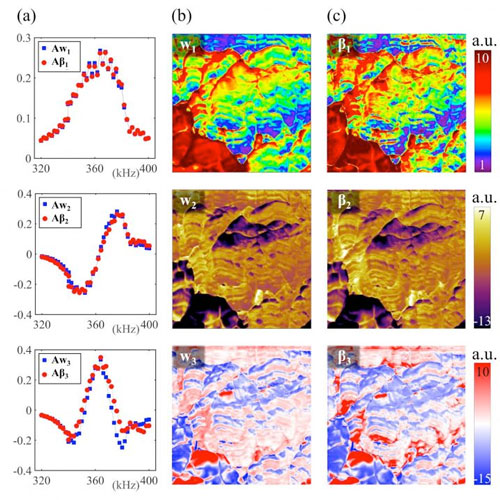| Nov 16, 2018 | |
Smart data enhances atomic force microscopy(Nanowerk News) Since its invention in 1986, atomic force microscopy (AFM) has emerged as a powerful tool to probe materials, structures, and devices at the nanoscale. In recent years, empowered by advanced data acquisition hardware and sophisticated data analytics, there is a strong push to bridge AFM and big data. It remains a daunting challenge, however, to draw clear mechanistic insights from brute force data analytics in AFM. |
|
| In a paper recently published in National Science Review ("Mapping intrinsic electromechanical responses at the nanoscale via sequential excitation scanning probe microscopy empowered by deep data"), a team at University of Washington demonstrates an innovative approach to address this difficulty. | |
 |
|
| This is a comparison of PCA and SHO expansion for SE-PFM data of PZT; (a) first three PCA spectral eigenvectors in comparison with corresponding SHO spectral basis; (b) first three PCA spatial eigenvectors; (c) corresponding SHO spatial basis. (© Science China Press) (click on image to enlarge) | |
| First, they develop a sequential excitation (SE) strategy that excites the sample using a sequence of AC waveforms with distinct frequencies, each capturing cantilever-sample resonance at selected spatial points that reflects the underlying physics. | |
| In a sense, such a SE strategy is analogous to Nobel winning super-resolution microscopy in biology that turns specific fluorescent molecules on and off in a sequential manner for imaging, after which the sequence of data can be reconstructed. This targeted acquisition ensures that the data is small yet of high quality, efficient, and physically relevant. | |
| While data reconstruction can be carried out by fitting physically motivated simple harmonic oscillator (SHO) model, the process is slow. Data analytic approach such as unsupervised principal component analysis (PCA) is highly efficient, yet lacks physical insight. | |
| The team, however, observe a strong similarity between data processed by SHO and PCA, as shown in the figure, and they are able to prove mathematically that there is a strong relation between SHO and PCA data, enabling them to deduce physical insight from PCA that is otherwise lacking. | |
| Using electromechanical coupling as an example, which is the scientific foundation for technologically important sensors, actuators and transducers, the team demonstrates that the new approach offers much better spatial resolution and accuracy in comparison with conventional approach. | |
| The connection between PCA and SHO data also makes it possible to speed up data analysis by orders of magnitude, critical for analysis on the fly in machine learning and artificial intelligence. Indeed, in another paper published in Nanoscale, the team has recently demonstrated an artificial intelligent atomic force microscope that is capable of classifying different materials, identifying key microstructure features, and carrying out additional probing for further insight, all on its own without human interference. |
| Source: Science China Press | |
|
Subscribe to a free copy of one of our daily Nanowerk Newsletter Email Digests with a compilation of all of the day's news. |
